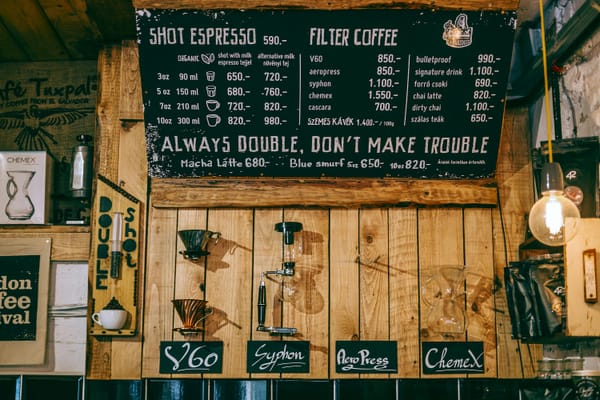Why you need to obsess with customer experience
Your obsession with the customer is not only about your product

One of the main recommendations you get when you start a company is "talk with your users" and "make something people truly want".
The connection between these things and success seems irredeemably obvious – we can only build something that lasts if we talk to people and understand their problems deeply.
Most of us have taken this advice to heart and have incorporated it fully into every aspect of our product-development-cycle. And while many founders might have a strong intuitive sense for needed product features, they will typically rely on insights gathered by talking with customers, seeing what problems they experience, figuring out why they have them, and then coming up with solutions.
Building a product is thus a continual process, the product a living organism. We seek alignment with customers.
However… some advice that you don't see that often is that growth is not only about your product, but about the entire customer experience.
People are not only buying your product, they buy:
- How they discover you
- What other people say about you
- How fast and transparent everything is
- How fast you respond & help them get started
- How you provide expertise & deal with stakeholders
- How it feels to deal with your company
- What you charge and how it works
- How you deliver on expectations after you start working together
- What your service levels are like
These are usually the areas where we start getting out of alignment with our customers.
The customer might have a certain price in mind that compares to their perceived value of your product. They might have expected you to frame your product and its messaging to the "correct" category they have in their heads. They might have expected to find a few reference customers in their industry. They might have expected a clear deck that explains the value of the product or service in a simple way that they could share with their boss, etc.
Non of these things are "the product", but they can definitely make or break a deal.
This is why Jeff Bezos famously said: "we're customer obsessed", when talking about growing Amazon. You need to feel deeply inside the mind of your customer and that is simply not only the product, but the entire experience.
While product is the most important element – if you truly care about acquiring new customers reliably, getting word of mouth recommendations, keeping existing customers for a long time, and expanding those customers – in short, if you want sustainable growth – you'll inevitably need to focus on every element of this customer experience.
Most companies rely on their relative departments: marketing, sales & customer success – but what most often lacks is the core alignment around what they're supposed to do exactly.
They'll focus on metrics like MQLs or deals closed, which are strong leading indicators, but they don't know WHY or HOW they're supposed to get it done. This is what creates endless cycles of: "let's try this channel", "let's re-organize", "let's change our website" and a 1000 more gimmicks all with the aim to do whatever makes the number grow, but never knowing WHY and pursuing something meaningful in unison with a long-term aim.
What's missing in these departments is the common vision that lets them determine whether something is worth pursuing or whether it's a waste of time and resources. What they actually have in common and what they should be obsessed with is two fundamental things: the obsession with the customer experience and how that customer experience translates into direct (recurring) revenue.
We can see that there is a lack of obsession with the customer in these departments simply by looking at the discrepancy by which we approach Product as part of the customer experience compared to other elements of it such as marketing campaigns, messaging, pricing, references, sales enablement, customer onboarding, customer success check-Ins, etc.
We have created meticulous processes for creating and delivering a great product, because that's what people want and need, but how many teams that you know of are running A/B tests on sales docs or are regularly interviewing customers on how their onboarding can be improved? The lack of obsession and the almost obligatory need to do these other parts in a "one-and-done" chore type of way are hurting your revenue. All of these parts are very much alive – and what you want to be is in complete alignment with your customer's expectations.
When we skimp on all these other areas, we inevitably start losing customers. And even if we don't lose out on customers, we lose out on significant revenue, retention and expansion opportunities.
This leads to the following conclusion: We must start talking with customers continuously and we need a strategy to optimize these other areas repeatedly.
The strategy we use and you can apply in your own startup consists of three areas: 1) talking with users 2) collecting data/insights from users and 3) applying your data/insights to continuously improve.
You could expand it further if you wanted to:
1) identify problem
2) gather data (by talking to users)
3) analyse data
4) generate solutions
5) select solutions
6) plan implementation
7) implement & test
8) review & continue to improve
And you're doing this accross tens of customer touchpoints to maximize the experience.
For transparency, here are the building blocks that make the customer experience for B2B SaaS, most of which can be broken down even further.
- Discovery
- How and where customers find out about you (marketing, branding).
- Reputation
- What people say about you (reviews, word of mouth, references)
- Value Communication
- How you communicate (messaging, engagement)
- Product
- What the product does and how well it works (features, usability).
- Pricing
- How and what you charge (pricing strategy).
- Delivery
- How you deliver on expectations (onboarding, uptime, new features).
- Service
- What your service levels look like (customer support, ongoing assistance)
As you can see, this is a kind of funnel where you'll find a continuous flow of potential revenue between point 1 and point 7.
Not delivering on point 7 may prevent another from reaching point 1. Being out of sync on point 5, may prevent the purchase and delivery on point 6. Any strong deviation of expectation or faulty part in that "customer experience" leads to a potential loss of earnings.
The truly interesting thing here is that maximizing customer experience is almost inextricably linked to maximizing your company value. So you're incentivized to do it. Why isn't your team following this process yet?
In the list, we're going in depth on each point and how to maximize it. Just follow each hyperlink to learn more.
Subscribe
SkaleUp is a boutique agency that works with fast-growing B2B SaaS startups to manage and implement growth. Subscribe to get our most recent posts in your inbox.

